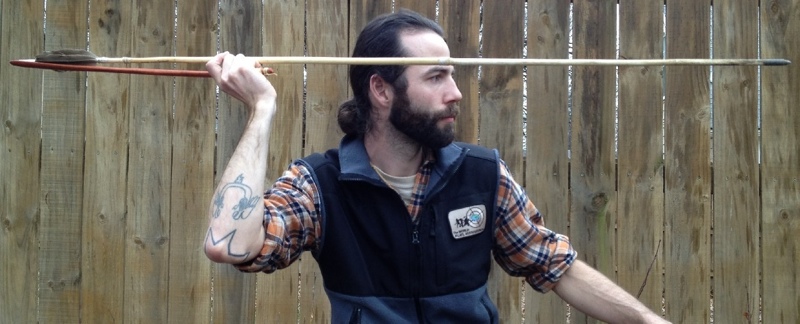Experiments in the use of an early Lovelock Atlatl and Dart assemblage from Kramer Cave, Nevada (site 26WA196)
Justin Garnett, 2011
In the world of replicative archaeology of projectile weapons, entire systems must be replicated in order to accurately evaluate equipment and it’s potential intended uses. Where possible, this allows new insights to be made into the complex behaviors associated with the production and usage of the weaponry. The best case scenario is one of total system preservation, such as was the case at the Basketmaker II sites at White Dog Cave, Arizona and the Ceremonial Cave site north of El Paso, Texas. In these cases entire darts and atlatls were recovered from the same contexts, allowing replicators to examine and reproduce matched equipment sets. At Kramer Cave (26wa196) we are not so fortunate- due to the fragmentary nature of both the atlatl and darts recovered from the site, it was impossible to directly obtain measurements of a complete dart, however the numerous fragmentary examples allow a generalized form to be reconstructed for testing. The atlatl was represented at the site by a distal portion, which was reconstructed with a simple hammer grip for reasons to be outlined below. All work was done with modern tools.
1) The site
Kramer Cave is situated on the south east slope of Falcon Hill, a large volcanic formation at the north end of the now-dry Lake Winnemucca. Prior to the damming of it’s inlets in the 1930s, lake Winnemucca followed an irregular cycle of drying and refilling, human habitation along it’s shores waxing and waning over time. Generations of people were alternately attracted to the region by rich, water dependent resources or driven away by drying and dwindling of the same resources. It was an existence of boom and bust, on a generational scale, within a largely lake-driven economy. Kramer Cave (And the other Lake Winnemeucca cave sites) were occupied or otherwise utilized during the “Boom” periods of this hydraulic cycle. Non-local artifacts such as Haliotis and Olivella shells indicate trade with or visitation of the California coast by these peoples. Kramer Cave appears to have only been utilized for a comparatively short period during the early Lovelock period, and was likely never a habitation site. Radiocarbon dates from the site range from 3,900 +/- 100 to 3,620 +/- 80 bp.
2) Physical description of the atlatl and darts
Atlatl:
The atlatl fragment recovered from Kramer Cave is the distal portion of a “Mixed type” integral spurred form. The wood has been identified as greasewood (Sarcobatus spp.). The atlatl is a unique design, shaped somewhat like a very long, elongated kitchen spoon terminating in a small, slightly raised spur. The distal 23.8 cm are flattened, like an atlatl of the Basketmaker culture, whereas the remaining proximal 14.3 cm are rounded and more narrow, terminating in a round cross section. Note must be made of an unusual and unique feature of this atlatl, that is, the attachment by 2-ply vegetable string loops of two small splints of wood 15cm long to its upper face. These splints were felt by Milder, 1974 to be “guides or supports for the dart shaft”. These rods may have served to strengthen a weak place on the atlatl, while functionally extending the dart trough along the face of the atlatl without cutting deeper into it and thus further weakening the board.
Kramer Cave Atlatl dimensions:
Table 1, atlatl dimensions – data from Hattori, 1982.
For my reconstruction, white ash (Fraxinus americana) was substituted for Greasewood, as it is unavailable in the region. I view the two sticks tied to the atlatl’s upper face as additional to it’s design, and have, as such, left them off the reconstruction. As none of the design parameters are functional, with the exception of the height of the spur, these were not carefully matched, but were reproduced in a general sense. The overall length of the reconstruction is 60 cm, and it was made to be thrown with a “Hammer grip”. This atlatl could also be reconstructed with fingerloops, as both are represented archeologically in the Lake Winnemucca area. The hammer grip is a good guess, as another atlatl attributable to the Lovelock Culture (The Lovelock Cave atlatl) is designed for this grip, as is the significantly older (8,400bp) Nicolarson cave atlatl (Site NV-WA-197) which was also recovered from along lake Winnemucca. From the nearby Shinners Cave site F (26WA203), also located on Falcon hill and described in Hattori 1983, came a stone atlatl spur, likely once part of a compound “Male form” atlatl of form similar to the Nicolarson Cave specimen. This spur is presumably attributable to the Lovelock culture, lending more credence to the idea of a hammer grip, although this support uses a good deal of inference. The length of the reconstruction was 60cm overall, because of user preference. This is similar to the Nicolarson Cave atlatl’s overall length of 58cm.
Darts:
Darts were badly fragmentary, but numerous fragments (37 dart fragments) were recovered, so a generalized reconstruction is possible and presumably representative of the type. Discussion of darts will proceed in 3 sections, since darts are compound and composed of 3 sections-Foreshaft, mainshaft, and hindshaft.
Foreshafts:
In this work, only complete foreshafts will be discussed. Complete foreshafts seem to fall into one of two groups, differentiated by overall length. Hattori calls these “Long” and “Short” types. It is important to note that the two types are quite distinct-there are no specimens which fall intermediate between the two categories, thus it seems the distinction is a real and valid one. (See table 2-overall lengths are similar within groups but dissimilar between groups).
Kramer Cave complete foreshaft dimensions (cm):
Table 2: dimensions of complete foreshafts – data reproduced from Hattori 1982.
Mainshafts:
Eight mainshaft fragments were recovered, ranging in length from 33.4cm to 67.8cm. All of these were Phragmites communis, except the longest fragment which was made of elderberry (Sambucus spp.) . It is doubtful that mainshafts were much longer than this, to judge by the diameter of the hindshaft fragments. The average diameter of these fragments was ~1.5cm at the distal end. Although it is uncertain how long intact mainshafts would have been, they would have likely been at least 50cm-67.8cm, and likely fell into what the designers would have considered an “Acceptable range”. This range would have been in my estimation between 50 and 100cm, depending on the dimensions of the foreshafts to be coupled to it-note foreshaft length is also variable.
Hindshafts:
Only one complete hindshaft was recovered. It’s overall length was 24 cm with a distal diameter of 1.01 cm and a steady taper to .78cm at the nock, which was .13cm in depth. The hindshaft was made of willow, and showed no evidence of bindings for fletches. Other fragmentary, possible hindshafts of Phragmites were also found, however their poor preservation precludes their usefulness to this work.
Kramer Cave Complete Hindshaft (cm)
 Table 3: dimensions of complete hindshaft – data from Hattori 1982.
Table 3: dimensions of complete hindshaft – data from Hattori 1982.
Reconstructions of darts:
As discussed above, no complete darts were recovered comprising any complete, connected sections; that is, no complete foreshaft was coupled with a complete mainshaft, and no complete mainshaft was coupled to a complete hindshaft. As such, averages and generalizations must be used in the reconstruction of darts. Theoretically, with a large enough sample size, average dart component dimensions would be more meaningful, and average, representative darts could then be constructed by selecting the most frequently occurring sizes of components and mating them. As this is impossible with the small samples afforded from this site, components must be somewhat arbitrarily reproduced. As such, a range of sizes of components were crafted. Darts were constructed from foreshafts and mainshafts of approximately equal length, within a range between 50cm and 60cm. Component maximum diameters for testing ranged from .85 to 1.3cm in diameter (Although a wider range was tested prior to settling on the 3 test darts, up to a diameter of 1.5cm). These were not an attempt to reproduce specific dart components, rather generalized, representative components within the range of dimensions represented by the Kramer Cave artifacts.
As evident from the above table (Table 2), long (>20cm) foreshafts were either of greasewood (Sarcobatus spp.) or Willow (Salix spp.). Interestingly, both long, self-pointed foreshafts are of greasewood, and both long, notched foreshafts are willow. This is presumably because of the greater durability of greasewood, or perhaps a function of density-lighter willow was used when stone points (Added tip weight) were to be used. I opted to reproduce the long, willow foreshafts. These were varying diameters, with an average around 1.1 centimeters, and were made from peeled shoots of Coyote Willow, Salix exigua, as were the hindshafts. To save on needless damage to stone points in testing, I decided to forgo the stone points and notches, instead opting for tapered tips and commercial 125 grain glue-on archery field points. This still made the foreshafts tip-heavy, and greatly simplified construction. 2 mainshafts were of Phragmites communis, one of black elderberry (Sambucus nigra).
My reconstructed darts, built with averaged and generalized dimensions as discussed above, fall between 143.5 and 146.5 centimeters in overall length with a maximum diameter at the distal end of the mainshaft of ~1.3cm. The weight of the complete darts is approximately two ounces, (60 grams) although this varies with dimensions. Foreshafts and hindshafts were given a slight taper on the ends which were then inserted into the midshafts, which, other than squared off cut ends and a heavy proximal and distal binding, were unmodified.
The best throwing dart in testing was 146cm in overall length with a balance point 36.64% from the distal (Point) tip. When rounded to the nearest centimeter, this is within the range 37-40%, which is what I consider optimal for unfletched dart performance-the balance point is actually on the foreshaft. No special care was needed to obtain this balance. All three darts reproduced for testing have natural balance points in the 37-40% from distal range, thus, all reproduced darts represent well-optimized projectiles, in terms of balance. Other darts with less fortunate inherent balance points could be balanced by shortening (Lengthening being obviously impossible) components slightly or switching out for longer components to adjust the balance point forward or back.
Although balance is near optimal, the darts, being short and somewhat heavy spined, are quite unforgiving of a poor throw, flying with an initial “Kicking down” of the nock end. This straightens out, and the darts fly well, but this makes them tricky to throw well.
Dimensions of generalized Kramer Cave dart replica foreshafts (cm):
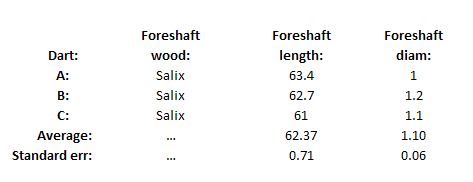 Table 4: dimensions of generalized replica foreshafts.
Table 4: dimensions of generalized replica foreshafts.
Dimensions of generalized Kramer Cave dart replica mainshafts (cm)
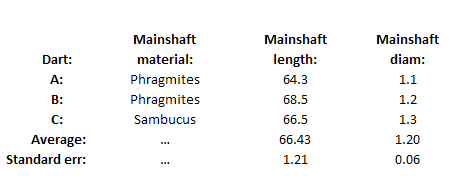 Table 5: dimensions of generalized replica mainshafts.
Table 5: dimensions of generalized replica mainshafts.
Dimensions of generalized Kramer Cave dart replica hindshafts (cm):
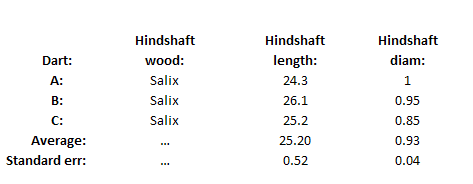 Table 6: dimensions of generalized replica hindshafts.
Table 6: dimensions of generalized replica hindshafts.
Dimensions of generalized Kramer Cave darts (Overall) (cm):
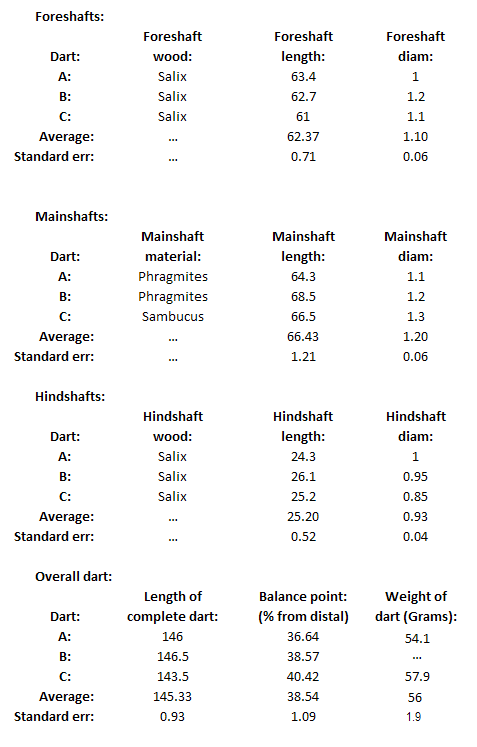 Table 7: dimensions of generalized replica darts.
Table 7: dimensions of generalized replica darts.
There is no direct evidence that the Kramer Cave atlatl dart fragments were ever fletched, but fragments of similar darts of similar age from Gypsum Cave, Nevada show evidence of having once been fletched with a 3 vane fletch. Also, the Leonard Rockshelter dart (A Humboldt culture dart with a separate hindshaft from site 26-Pe-14), also from Nevada, bears a 2-feather tangent fletch. This complete dart was recovered from the lowest excavated level at Leonard rockshelter with associated organic samples dating to ~7,088 +/- 350bp . The samples in question comprised of three greasewood dart foreshafts, with no other specific details given (Heizer, 1951).
Therefore, it is not unreasonable to think that at least some of the Kramer Cave darts would have been fletched, as the technical know-how to do so was present in the area at that time-indeed, for a long time prior to the lovelock period, if Heizer’s radiocarbon dates are accurate.
For this reason, three fletched hindshafts were produced, each bearing a tangent fletch composed of the middle portion of two Giant Canada Goose (Branta canadensis) secondary flight feathers 12cm long by 3cm wide. (One dart hindshaft fragment from Kramer cave bore a red painted spiral 12cm in length at it’s mid point-spiral painting often been placed under fletches in archaeological contexts in the area) These hindshafts, although bearing comparatively short fletches , straightened out the flight of the darts very nicely, improving their performance from usable to excellent.
I then produced a 28cm long tangent fletched hindshaft for dart C (Mainshaft of elderberry) using two whole Giant Canada Goose secondary flight feathers 15cm long by ~5cm wide. This put Dart C in it’s final configuration. Although the balance point has moved back somewhat, this change is more than corrected for by the fletching, and dart C is now every bit as well-handling and throwing as any of the best darts I own.
Dimensions of dart “C” with fletched hindshaft (Overall):
Table 8: dimensions of generalized replica dart C, in final configuration.
Kramer Cave speculative Atlatl replica (a) and Dart C, disassembled, mainshaft (b), foreshaft (c), unfletched hindshaft (d), and fletched hindshaft (e). Scale is in 5cm blocks.
Kramer Cave speculative Atlatl and dart replica held for use.
3) Discussion
Due to a near optimal balance point, these darts as reconstructed fly well enough to be usable projectiles without fletches, and would make serviceable weapons as-is, however there is, due to comparatively stiff spine a tendency for the tails to “kick down”, effecting flight early in the cast-this condition can be entirely corrected by addition of even the most basic and minimal fletching, making these darts into well-functioning, well handling accurate weapons. In my opinion, these darts represent a dart-making tradition very distinct, but certainly no less sophisticated or effective than that of the later Basketmaker II culture.
The Kramer Cave people were non-agricultural hunter-gatherers, for whom mobility would have been critical-their environment changed on a yearly basis due to the fluctuating levels of Lake Winnemuccca. Their darts (And the Humboldt dart from Leonard rockshelter) were shorter still than those of the Basketmakers. Also notable is the fact that these darts are held together by friction joints, which, whether glued or not could be disassembled into 3 components for easy carrying. An Early Lovelock hunter could have carried a quiver filled with disassembled darts while hiking to his or her hunting grounds, and assembled darts on site, limiting accidental breakage, injury, or other misshap during travel. In any event, and whatever the logic behind them, these darts represent a no less elegant and well designed projectile than those of later cultures of the Great Basin and North America as a whole.
Hattori, 1982
1982, The archeology of Falcon Hill, Winnemucca lake, Washoe County, Nevada. Eugene M. Hattori. Nevada State Museum Anthropological Papers – Number 18.
M.P. Milder
1974 , Great Basin Atlatl Studies, R.F. Heizer, M. P. Mildner, and L. Spencer. Ballena Press
Heizer, Robert F.
1951 Preliminary Report on the Leonard Rockshelter Site, Pershing County, Nevada. American Antiquity 17(2):89-98.






